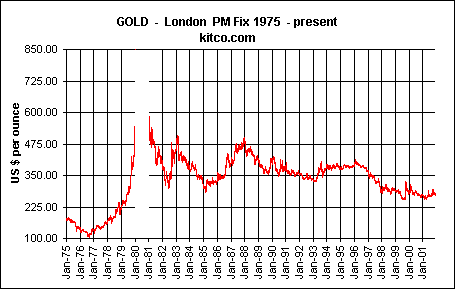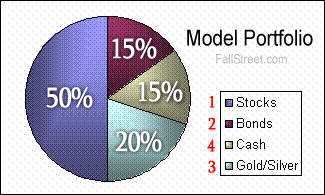February 5, 2002
Is Richard Russell The New James Glassman?
Richard Russell, who has published The Dow Theory Letters since 1958, hasn’t always been a die-hard gold bug. Given his reputation and apparent objectivity when it comes to gold, it is not surprising that Russell is quickly becoming the poster child for the latest gold rush. And while Russell admits that he doesn’t know exactly how high gold will go, he does use the 1979-1980 gold mania as a template for a ‘guess’:
“If the current gold bull market was to take gold to a comparable 1980 high, gold would rise to above $1,800 (To convert 1980 dollar to current dollars multiply by 2.1819). But in my opinion, the current situation is far more serious than it was in 1980 -- and far more bullish for gold.” Russell. 321Gold.
To begin with, that Russell implies gold will reach, at minimum, $1800 an ounce because the ‘current situation’ is more serious that it was in 1980 is suspect. To be sure, when you back out 1980, a period when demand for gold was not unlike the demand for internet stocks in 1999, gold has spent very little time above $475 an ounce. Using $475 an ounce as a ‘top’, Russell’s $1854 call slips to $1036.
 |
Furthermore, the assumption made by Russell that gold must, for some reason, be chained to the historical purchasing power of the dollar is also suspect. Has no gold been mined since 1980? Have no new proven and probable reserves been discovered since 1980? If increasing the money supply reduces the dollars purchasing power (causes inflation) does not increasing the gold supply have a similar effect on gold?
Suffice it to say, in determining that gold is set for further gains many investors, including Russell, use the 1980 peak as a guide for future gains because other guides (i.e. the actual price of the metal) do not paint gold in as bullish a light. Think about it: is it rational to look at gold’s performance over the last 30 years – which represent the first 30 years in a row gold has been floating freely versus currencies – and argue that $1800 an ounce is achievable? Is the biggest gold bull market ever really upon us?
|
|||||||||||||||||||||||||||||||||||||||||||||||||||||||||||||||||||||||||||||||||||||||
Granted, there are clear signals that gold is in new bull market; producers are hedging less gold, central banks are not selling gold (but buying), and investor’s are leaning towards gold as a crisis/currency hedge. Nevertheless, the point the Russell’s ignore is that if gold continues higher, which it could very well do in the coming years, this would mean that other asset classes are likely to become more attractively priced. Using the logic that as gold steps higher other assets (i.e. stocks) are likely to step lower, this places a perceptive limit on gold’s allure. For example, would you rather own the Dow at 1,000 or gold at $1000 an ounce?
In short, $1800 an ounce gold is possible, as is $20,000 an ounce or even $100,000 an ounce gold. However, and not unlike James Glassman forecasting Dow 36,000 as stocks soared, Russell’s ‘guess’ of where the price of gold is headed is biased and useless.
The Gold Story
Let me first state that when it comes to gold I am also biased. For certain, I firmly believe that the gold bull market is, as Russell states, ‘in its first (psychological) phase.’ However, I try to avoid using baseless price targets for shock value.
With this in mind, and through the aid of hindsight, gold’s peak in 1980 was good for only one thing: selling. In fact, any investor who blindly dumped money into gold at anytime during 1980, perhaps under the assumption that gold must be apart of their portfolio at any cost, is still losing money today.
* Is 23 years really a fair time frame to judge gold?
Few of us are going to live for 100 years and even fewer investors have an investment horizon of more than 40 years...as such, why in the world should any investor care how great an asset gold is over the last 5,000+ years? (the popular argument from die hard gold bugs is that gold is a good investment because it has ‘longevity’).
In short, the advanteges of gold investing are as follows: If you put $385 U.S. and 1-ounce of gold under your mattress today, 30-years from now the $385 U.S. will – without doubt – have less purchasing power. By contrast, gold could be worth more than $385 an ounce.
Despite premonitions of extreme inflation/deflation -- the unpredictable menaces that everyone is trying to forecast -- gold is a hedge against the inherent risk of owning currency. Sometimes buying gold can be risky and sometimes (most times) buying gold is safe. End of story.
Buy Gold Now?
I would not buy gold now simply because it has had a significant run-up in anticipation of an Iraq war and/or further U.S. dollar erosion. That said, I also believe that the price of gold has not yet reached a price that is screaming sell either.
What does this ‘on the fence’ logic mean? I would immediately begin to sell my hard gold if other options (i.e. undervalued equities) presented themselves, but since there are few ‘other’ options available at this time (of the paper backed variety) I want to hold onto my gold. I would also begin selling gold even if no other options, save money markets, were readily available if I believed the market was purely ‘mania’ based (a judgment call).
With this in mind, and since speculation is what analyzing the gold market seems to be all about – here are my gold thoughts expressed using a basic Investment Model. To note: I don’t back the idea of forced asset allocation, but it serves a purpose to use a model when discussing gold.
 |
1) Most stocks, including gold stocks, are not at attractive levels. The investor needs to be selective and prepared to dollar cost average.
2) Even though bond yields are unattractive they could drop further as investors seek safe haven from falling equities/geopolitical tensions. By contrast, bonds could also slump (yields would spike) if monetary and fiscal stimulus plans achieve any degree of ‘traction’.
3) Gold is strong and silver is semi-strong.
4) Nothing wrong with being liquid in cash.
From these points the investor is left with the following gameplan:
If stocks continue to fall and gold continues to rally it may be prudent to sell some hard gold and put more money into solid stocks. If gold continues to rally while silver does not and stocks remain unattractive, it may be a prudent to sell hard gold for hard silver. It may be prudent to stay away from longer dated bonds (Treasurys) as yields are at historically low levels and/or not attractive.
Incidentally, when I mention ‘hard’ gold/silver I am not referring to coins or small denominations of bullion. For example, if gold spiked higher I would not dump gold and run out and buy silver eagles (which carry hefty premiums), but would buy 1000 ounce bar(s) of silver that are more closely hinged (less premium) to the price of the underlying metal. Yes, for the longest time whenever Todd and I mentioned gold/silver we always referred to ‘coins and bullion’. However, as we get closer to what could be a ‘risky’ level in gold the premiums on coins are becoming more difficult to accept.
Final Notes
“It still (gold market) must go through its second phase which will see the entrance of the public and the funds.” Russell
During this second phase of the gold bull – when people are scared of holding paper assets – the astute investor will look to sell some gold and buy some beaten down stocks. Given that stocks remain extremely overvalued (as well as the US dollar), the basic speculation is that we are not at this point yet.
As for my attack on Russell, my distaste for his points of view were especially hardened by his answer to the question, ‘why aren't the gold stocks keeping up with gold?’
“When the US public finally becomes interested in gold, they won't buy the metal, they will buy the gold shares. That hasn't happened yet.”
Hasn’t happened yet??? Of the 24 gold stocks with positive ROE listed below the average stock is up more than 100% from its 52-week low. Furthermore, gold stocks have been the top performing funds for the last two-years, and after not being mentioned at all during the late 1990s CNBC has actually had multiple guests on mentioning gold in a positive light ever since $300 an ounce was breached. If these signals do not show renewed ‘interest in gold’ I don’t know what does.
As for Russell’s assumption that the US public will rush to gold stocks as opposed to the metal, I can guarantee one thing: gold will never see $1800 an ounce simply because people want to buy gold shares. Rather, if gold rallies to such unthinkable levels it will be because people hoard gold (Although most of the global statistics for 2003 gold demand will take a few months to trickle in, the U.S. Mint is already reporting that 96,000 ounces of gold where sold in January 2003. It took 7 months for 96,000 ounces to be sold by the mint last year.)
Demand for gold, along with the price of gold, is up sharply this year while, after today, both the XAU and HUI are slightly lower on the year. How long has this Russell character been around?
|
|||||||||||||||||||||||||||||||||||||||||||||||||||||||||||||||||||||||||||||||||||||||||||||||||||||||||||||||||||||||||||||||||||||||||||||||||||||||||||||||||||||||||||||||||||||||||||||||||||||||||||||||||||||||||||||||||||||||||||||||||||||||||||||||||||||||||||||||||||||||||||||||||||||||||||||||||||||||||||||||||||||||||||||||||||||||||||||||||||||||||||||||||||||||||||||||||||||||||||||||||||||||||||||||||||||||||||||||||||||||||||||||||||||||||||||||||||||||||||||||||||||||||||||||||||||||||||||||||||||||||||||||||||||||||||||||||||||||||||||||||||||||||||||||||||||||||||||||||||||||
|
|
All data and information within these pages is thought to be taken from reliable sources but there is no guarantee as such. All opinions expressed on this site are opinions and should not be regarded as investment advice.
Copyright © 2000, 2001, 2002
FallStreet.com